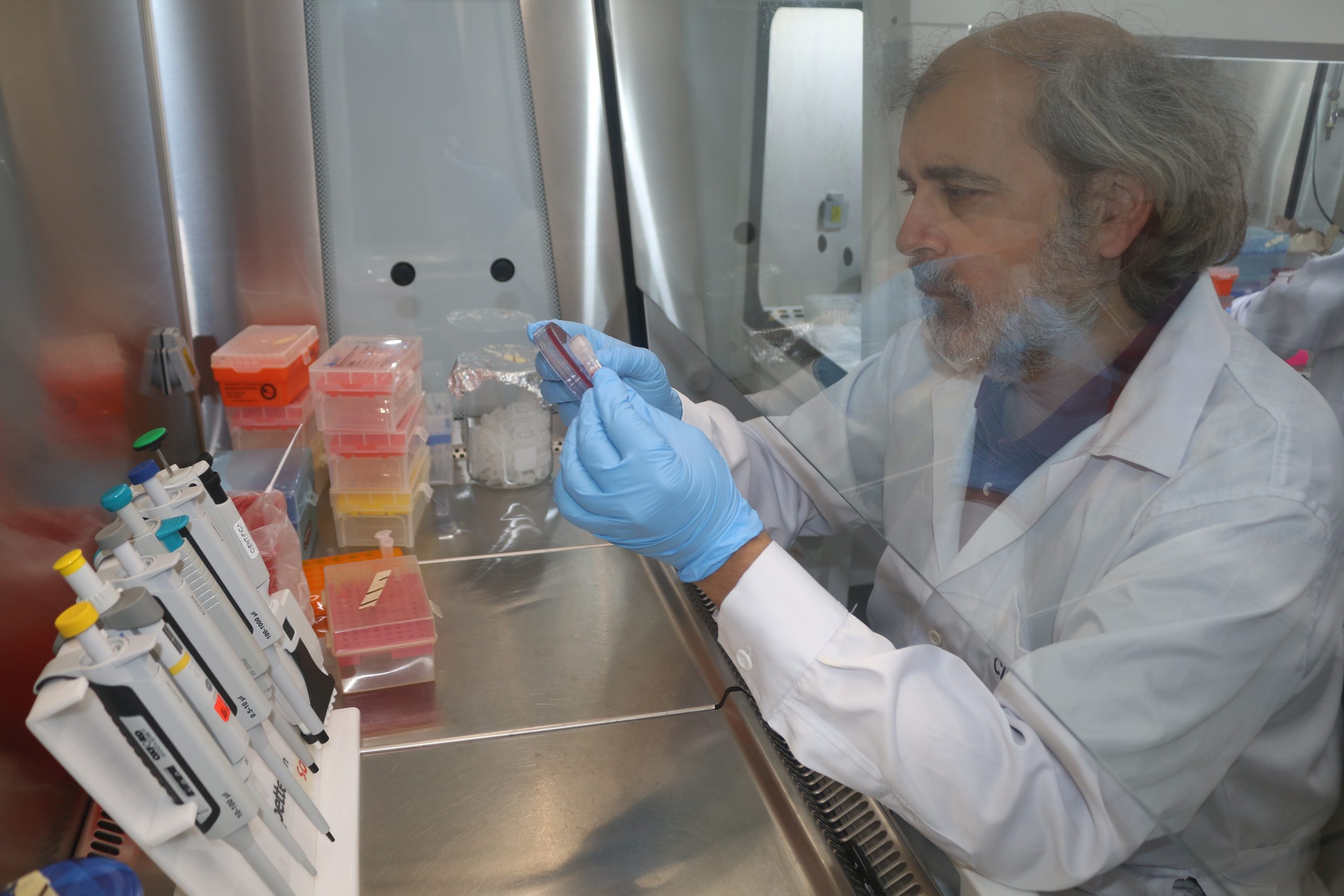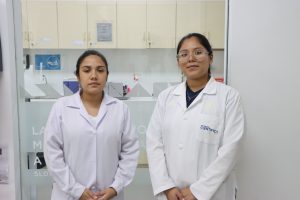El laboratorio se enfoca en la caracterización de los mecanismos de resistencia a antibióticos en bacterias de relevancia clínica, alimentaria, animal y ambiental.

El laboratorio se enfoca en la caracterización de los mecanismos de resistencia a antibióticos en bacterias de relevancia clínica, alimentaria, animal y ambiental.
Jefe del laboratorio
Joaquim Ruiz Blazquez

Rosario Del Pilar Oporto Llerena – Investigadora Asistente
Gabriela Jareth Silva Zamora – Auxiliar Técnico de Laboratorio
Microbiología, infecciosas y one health
Baño Maria
Camara de Electroforesis con fuente de poder
Balancin Digital Compacto (Rocker Digital)
Transiluminador
Incubadora de Cultivo Digital
Sistema de Documentacion de Geles
Termociclador
Espectofotometro Cinetica
Sistema de Electroforesis de Campo Pulsado
Microscopio Binocular LED
Cabina de Bioseguridad Clase II
Secuenciador de Tercera Generación en Nanoporos en Tiempo Real
Caracterización de los mecanismos de resistencia a antibióticos
Investigación de las dinámicas y niveles de resistencia

Background Antimicrobial resistance (AMR) has emerged as a priority for both public health and the global economy. Moreover, information on AMR is scarce, particularly in low/middle-income countries. We evaluated the direct economic cost of microorganisms and AMR. Methods We performed a cross-sectional study to assess the economic costs of neonatal cases diagnosed with bacteremia at the Instituto Nacional Materno Perinatal in Lima, Peru, from January 2017 to June 2018. We used cost invoices calculated by the micro-costing bottom-up approach, as well as the strain identification and antimicrobial susceptibility data, to estimate the direct costs. Results The average costs of bacteremia were US$349 (SD 403) for multidrug-resistant (MDR) strains and US$276 (SD 349) for non-MDR strains. Costs were higher for microorganisms associated with late-onset sepsis (LOS). We found that LOS, multidrug resistance and age were significantly associated with bloodstream infection (BSI) costs. Also, all microorganism groups were associated with increased costs, with the highest average costs for Acinetobacter, followed by Pseudomonas. Conclusions In Peru, BSI costs are strongly associated with AMR. Furthermore, costs increase significantly with LOS, multidrug resistance and the patient's age. We urge health authorities to strengthen measures and strategies against the pressing threat of AMR.

Background: The blaSCO-1 gene, which codes for a carbenicillinase, is an uncommon β-lactamase. To the best of our knowledge, we report the first instance of a Klebsiella pneumoniae clinical high-risk isolate carrying blaSCO-1 in Peru. Objectives: To characterize a K. pneumoniae clinical isolate carrying blaSCO-1 in Peru, isolated from a tertiary care hospital in Lima, Peru. Methods: Susceptibility to amoxicillin/clavulanic acid, amoxicillin/sulbactam, piperacillin/tazobactam, aztreonam, ceftriaxone, cefotaxime, ceftazidime, ceftazidime/avibactam, cefepime, imipenem, meropenem, ciprofloxacin, trimethoprim/sulfamethoxazole, gentamicin, amikacin and tigecycline was determined using the Kirby–Bauer disc diffusion method. Detection of blaSCO-1 was established by Illumina WGS and bioinformatic analyses. All the publicly available genomes from K. pneumoniae carrying blaSCO-1 from the American continent were downloaded from the NCBI Isolates browser for assessment of phylogenetic comparisons. Results: The isolate showed resistance to all the tested antibiotics except for ceftazidime/avibactam, carbapenems and tigecycline. Illumina WGS showed the presence of blaSCO-1 and blaOXA-1, blaSHV-28, blaTEM-1, blaCTX-M-15, as well as genes associated with resistance to quinolones, fosfomycin, aminoglycosides, sulphonamides, trimethoprim and phenicols. Moreover, the isolate was ST307, a high-risk clone of K. pneumoniae usually associated with blaCTX-M-15 and/or carbapenemases. Notwithstanding, the latter were not found on this isolate. Phylogenetic relationships were established by comparisons with 19 K. pneumoniae genomes carrying blaSCO-1 from other countries in the Americas, revealing at least three different clades. Conclusions: This study highlights the importance of genomic surveillance of uncommon antimicrobial resistance genes such as blaSCO-1, which might contribute to further antimicrobial resistance levels in this country.

Five carbapenem-resistant P. aeruginosa isolates were obtained from 33 adult Guanay Cormorants from Isla Pescadores, Lima, Peru. Four isolates had a similar antibiotic susceptibility profile and their carbapenem resistance was attributed to mutations in OprD porin; whilst the last isolate carried both blaVIM (encoded within a Class 1 integron) and blaIMP. Moreover, the VIM/IMP co-producer belongs to ST111, considered as a high-risk clone. The other isolates could not be identified by MLST since amplification of mutL, aroE, and acsA could not be achieved. The exoA and exoT genes were present in all isolates, while the VIM/IMP isolate also carried exoS and exoY but neither exoU nor algD. BOX-PCR showed that the VIM/IMP isolate was not clonally related to the other four. These findings highlight the importance of surveillance and characterisation of carbapenem-resistant bacteria from environmental sources in Peru. © EcoHealth Alliance 2025.

This study aimed to analyze Escherichia coli from marketed meat samples in Peru. Sixty-six E. coli isolates were recovered from 21 meat samples (14 chicken, 7 beef), and antimicrobial resistance levels and the presence of mechanisms of antibiotic resistance, as well as clonal relationships and phylogeny of colistin-resistant isolates, were established. High levels of antimicrobial resistance were detected, with 93.9% of isolates being multi-drug resistant (MDR) and 76.2% of samples possessing colistin-resistant E. coli; of these, 6 samples from 6 chicken samples presenting mcr-1-producer E. coli. Colistin-resistant isolates were classified into 22 clonal groups, while phylogroup A (15 isolates) was the most common. Extended-spectrum β-lactamase- and pAmpC-producing E. coli were found in 18 and 8 samples respectively, with blaCTX-M-55 (28 isolates; 16 samples) and blaCIT (8 isolates; 7 samples) being the most common of each type. Additionally, blaCTX-M-15, blaCTX-M-65, blaSHV-27, blaOXA-5/10-like, blaDHA, blaEBC and narrow-spectrum blaTEM were detected. In addition, 5 blaCTX-M remained unidentified, and no sought ESBL-encoding gene was detected in other 6 ESBL-producer isolates. The tetA, tetE and tetX genes were found in tigecycline-resistant isolates. This study highlights the presence of MDR E. coli in Peruvian food-chain. The high relevance of CTX-M-55, the dissemination through the food-chain of pAmpC, as well as the high frequency of unrelated colistin-resistant isolates is reported.

Background and Aim: Established antimicrobial resistance (AMR) surveillance in companion animals is lacking, particularly in low-middle-income countries. The aim of this study was to analyze AMR and its risk factors in Escherichia coli isolated from dogs at two veterinary centers in Lima (Peru). Materials and Methods: Ninety dogs were included in the study. Antimicrobial susceptibility was established by disk diffusion, whereas microdilution was used to determine colistin susceptibility. Mechanisms related to extended-spectrum β-lactamases (ESBL) and colistin resistance were determined by polymerase chain reaction. Clonal relationships of colistin-resistant isolates were assessed by XbaI-pulsed-field gel electrophoresis. Results: Thirty-five E. coli strains were isolated. High levels of resistance to ampicillin (57.1%), nalidixic acid (54.3%), tetracycline (48.6%), and azithromycin (25.7%) were detected. Cephalosporin resistance levels were ≥20% and those for colistin were 14.3%. Twelve (34.2%) isolates were ESBL producers; of these, six blaCTX-M-55 (50.0%), 2 (16.6%) blaCTX-M-15, and 2 (16.6%) blaCTX-M-8-like genes were found. The five colistin-resistant isolates were clonally unrelated, with four of them presenting amino acid codon substitutions in the mgrB gene (V8A) or mutations in the mgrB promoter (a12g, g98t, and c89t). Furthermore, dog age, <6 years (p = 0.027) and raw diet (p = 0.054) were associated with resistance to a greater number of antibiotic families. Conclusion: Despite small number of samples included, the study found that dogs studied were carriers of multidrug-resistant E. coli, including last-resort antimicrobials, representing a public health problem due to close contact between dogs and humans. This issue suggests the need for larger studies addressed to design strategies to prevent the spread of resistant micro-organisms in small animal clinics and domestic settings.